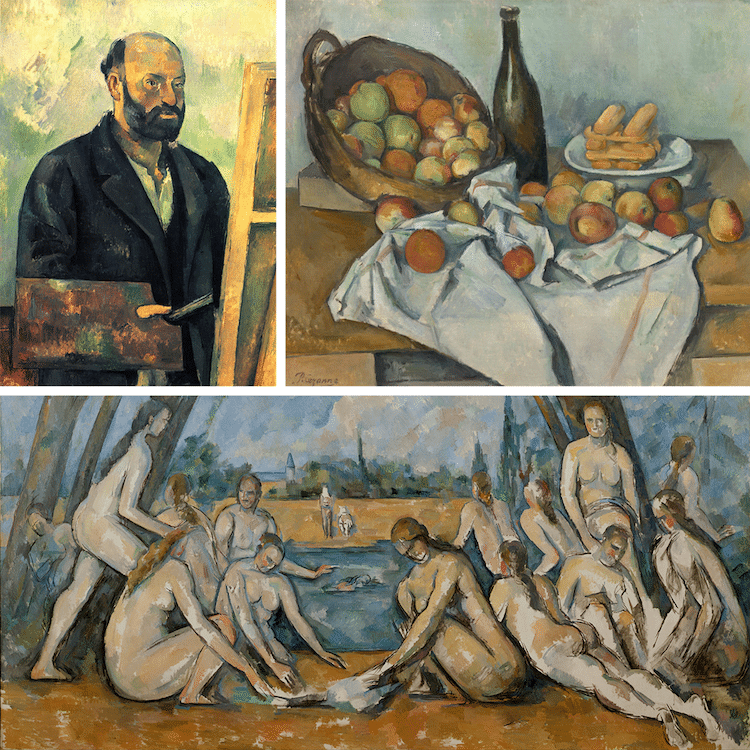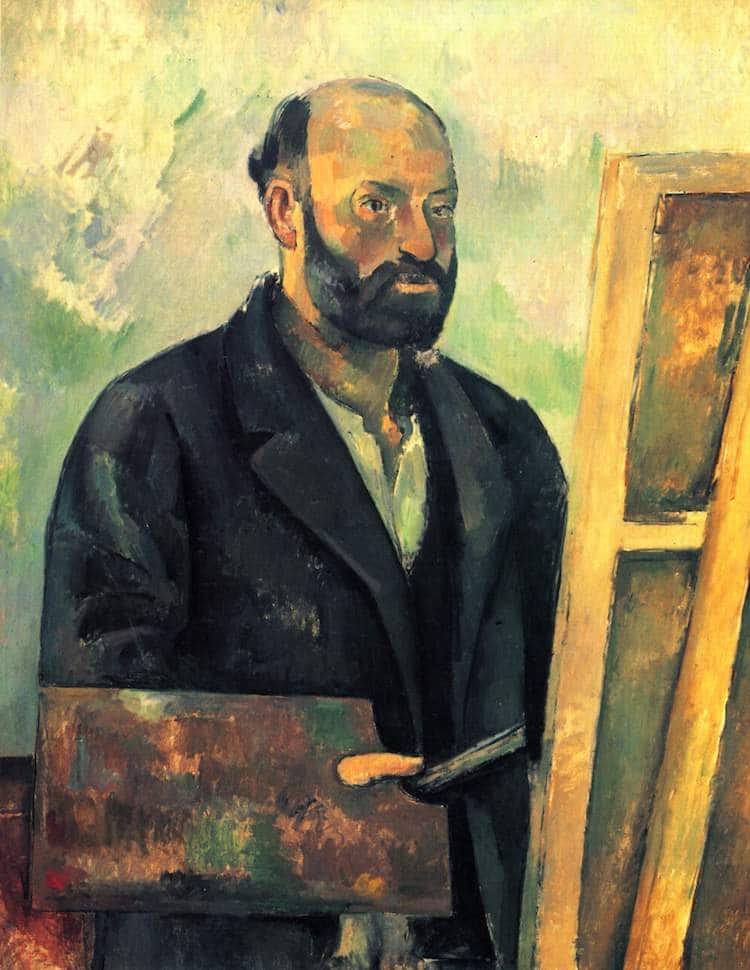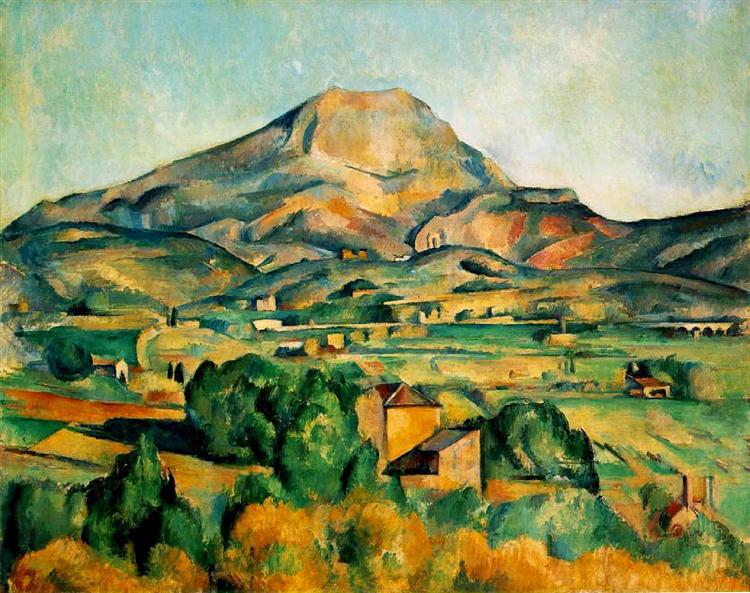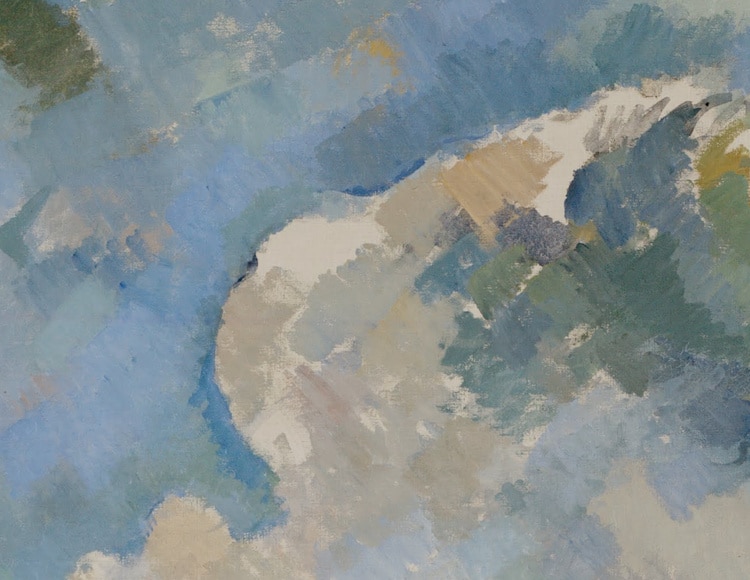ââåi Want to Make of Impressionism Something Solid and Lasting Like the Art in the Museumsã¢ââ

This post may comprise affiliate links. If you make a purchase, My Modern Met may earn an chapter commission. Delight read our disclosure for more info.
In the late 19th century, Postal service-Impressionism emerged in France. Unified past a subjective approach to painting, this major art movement was pioneered past Vincent van Gogh and Paul Cézanne, a French painterwhose work ischaracterized by painterly brushstrokes, an avant-garde approach to perspective, and a brilliant color palette.
In addition to his role every bit an important Post-Impressionist, Cézanne is celebrated as the forefather of Fauvism and a forerunner to Cubism. Given his prominence in these groundbreaking genres, Cézanne is regarded every bit 1 of the most influential figures in the history of modern art.

"Cocky-Portrait with Palette," c. 1890 (Photograph: The Yorck Project via Wikimedia Commons Public Domain)
Who is Cézanne?
Paul Cézanne was born in Aix-en-Provence, a district in the south of French republic, in 1839. While he lived and worked primarily in this region, he too spent time in Paris, where he exhibited with Impressionist artists like Claude Monet and Mary Cassatt.
While he worked closely with these figures, he did not consider himself an Impressionist. Different the Impressionists, Cézanne preferred painting in a studio to working en plein air. He rejected their seemingly spontaneous brushwork and favored organized, orderly compositions. He also was non interested in capturing fleeting impressions of his subjects—a key feature of Impressionism—and focused on symbolism and substance over style. "I wanted to make out of Impressionism something solid and lasting like the fine art of the museums," he explained ( Joachim Gasquet's Cézanne: A Memoir With Conversations ).
As a consequence of this artistic approach, Cézanne developed a one-of-a-kind aesthetic distinguishable from that of his contemporaries.
Aesthetic
"Effective" Brushwork
Early in his career, Cézanne used palette knives to produce heavily textured paintings. Later working aslope the Impressionists, all the same, he was inspired to embrace new methods of pigment application.
Similar the Impressionists, he adopted a "cleaved brushwork" technique. Different the quick, sketch-like brushstrokes feature of Impressionism, however, Cézanne employed "constructive strokes"—meticulously arranged marks that that worked together to create geometric forms. As Cézanne avoided the use of dark lines, he relied on this contrasting brushwork to "define the outlines of objects when their points of contact are tenuous and delicate."Bright Color
In improver to painterly brushstrokes, Cézanne's paintings are as well characterized by a recognizable color palette. While many of his early works are rendered in somber tones, he eventually adopted a preference for planes of saturated hues.
This tonal handling is particularly pronounced in his landscapes, like his radiant views ofMont Sainte-Victoire. In this sun-baked series, Cézanne reduces the mountains, copse, and Mediterranean homes of the Provençal countryside to fragmented-nonetheless-harmonious blocks of color. These polychromatic planes add together a sense of depth to each panoramic depiction and showcase Cézanne'due south avant-garde approach to representing nature. "I was pleased with myself when I discovered that sunlight could non be reproduced," he explained, co-ordinate toRenoir. His Life and Work. "It had to be represented by something else…by colour."

"Mont Sainte-Victoire," c. 1895 (Photo: via Wiki Art [Public Domain])
Skewed Perspective
In his paintings, Cézanne oft rejected realistic portrayals of space in favor of more than creative compositions. This is peculiarly axiomatic in his still-life depictions, which oftentimes characteristic fruit, bottles, and other everyday objects counterbalanced on tilted, topsy-turvy tabletops.
In these paintings, Cézanne played with perspective and flattened surfaces to show the aforementioned arrangement from multiple angles at in one case. He achieved this by emphasizing each individual object rather than the scene every bit a whole, culminating in eye-catching, off-kilter compositions. This principle of distortion would later play a major role in Cubism, as artist Georges Braque noted in 1957: "The hard-and-fast rules of perspective which information technology succeeded in imposing on art were a ghastly mistake which information technology has taken four centuries to redress; Paul Cézanne and after him Picasso and myself can take a lot of credit for this." When paired with his analytical brushstrokes and vivid color palette, information technology is this unique approach to perspective that would eventually lead Picasso to telephone call Cézanne "the father of us all."Pregnant Works
The Menu Players
During the early on 1890s, Cézanne produced a series of five paintings chosen The Card Players. Although these works focus on like discipline matter, they differ slightly in the number of figures and stylistic approaches.
The Card Players painting from 1894–1895, for example, is 1 of three canvases that describe two card players at a tabular array. Due to its later completion, this piece in item contains more than "constructive" brushwork—foreshadowing the quintessential style of Cézanne's later years.
The Bathers
Cézanne's magnum opus, which is also widely regarded equally one of the masterpieces of all modern art, is called The Bathers. This big oil painting spans most seven x 8 feet and depicts a group of naked women relaxing by a lake. Cézanne painted several versions of the subject throughout his career and spent seven years working on the most famous representation, which was left unfinished at the time of his decease in 1906.
This yard painting recalls the works of classical masters such equally Titian and Rubens in its content. Like them, Cézanne captured an atmosphere of romantic leisure. Withal, to stay true to his own artistic indicate of view, the Post-Impressionist abstracted the figures and background in strong, geometrical shapes. 
Detail of "The Bathers"
Related Articles:
Tracing Van Gogh's Life Through 5 of His Well-nigh Significant Self-Portraits
Who Is Titian? Exploring the Life and Art of the Renaissance Principal of Colour
The Significance of Botticelli's Renaissance Masterpiece 'The Birth of Venus'
The History of Cupid in Art: How the God of Beloved Has Inspired Artists for Centuries
Source: https://mymodernmet.com/paul-cezanne-paintings/
0 Response to "ââåi Want to Make of Impressionism Something Solid and Lasting Like the Art in the Museumsã¢ââ"
Post a Comment